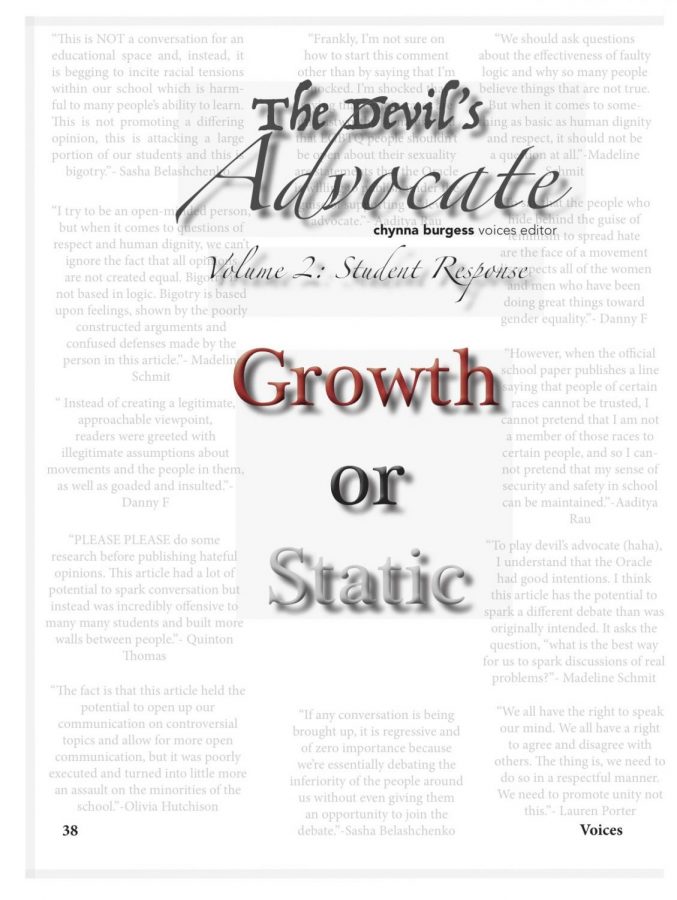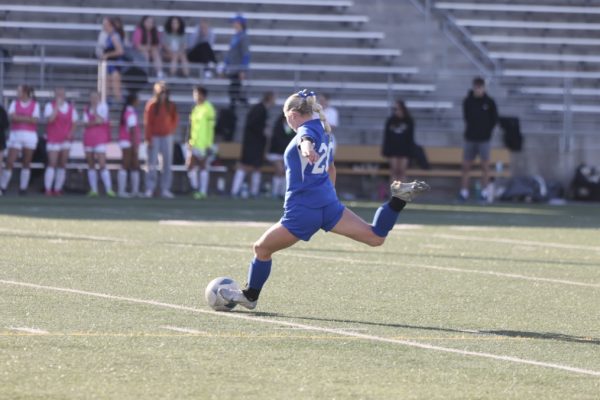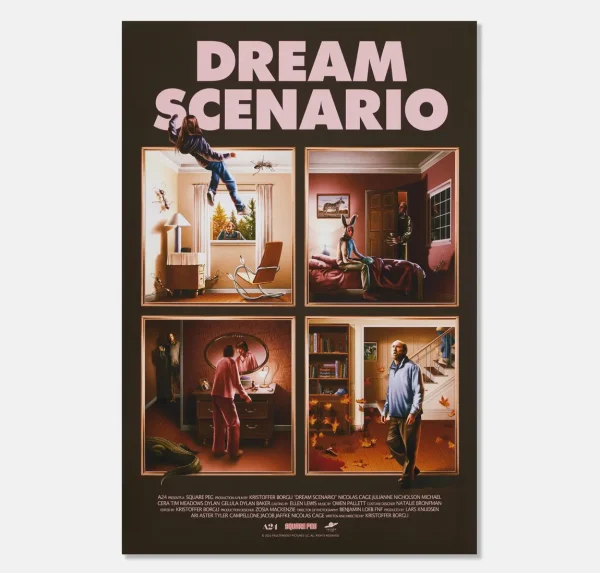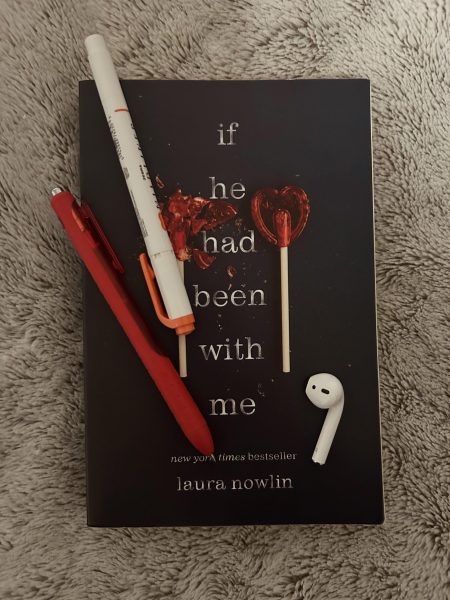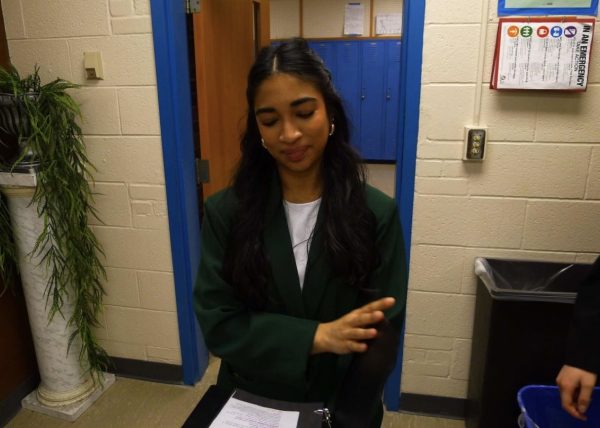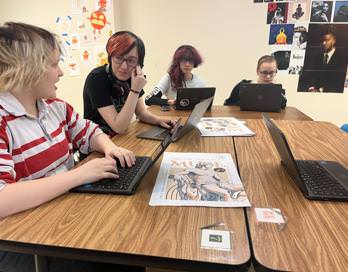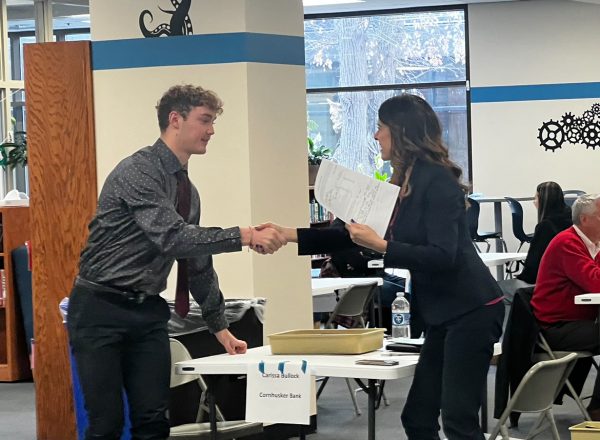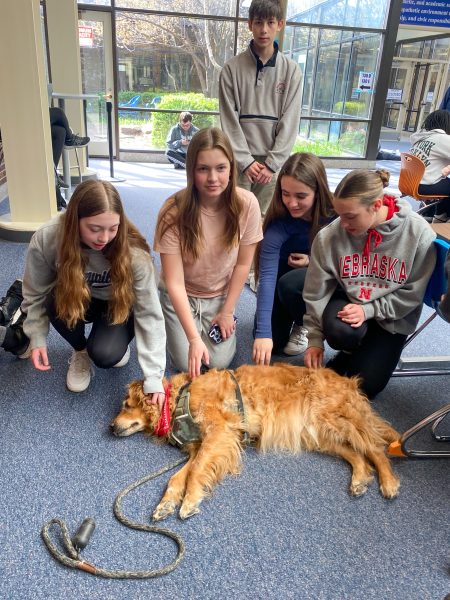Devil’s Advocate Volume 2
For this final edition, I pushed to address my last editorial, “The Devil’s Advocate”. The responses from the article mostly expressed anger as well as dismay, but a few even voiced approval. The opinions expressed in the last editorial were difficult for many to rationalize, especially because they were deliberately unsupported by evidence. For the final edition, I sought out face-to-face feedback from our student body in an effort to see what could be learned from the students.
The views expressed in the article were racist, and it’s easy to tell someone they’re being too sensitive if they felt targeted or attacked. The views were homophobic, and the views were sexist. Telling someone they’re sensitive does not work if you aren’t in their shoes. The likeliness of the whole student body just being sensitive is unlikely. There is a reason the student body caused an uproar, and sensitivity isn’t one of them.
Minority groups had the harshest reaction, and these were the people I wanted to hear from. I wanted to hear about their experiences with discrimination, the reason the editorial bothered them, and most of all their stories.
My editorial team consisting of Oracle staff members Lilliana Irvine, Morgan Valley, and myself, went in search of a moment of growth.
Shruti Mishra is a senior here at East. She became very passionate about the Devil’s Advocate article fairly quickly. She wrote an essay (which can be read on our online edition). After reading her essay, I wanted to sit down with her and hear her story.
She explained that upon reading the piece she felt a sense of betrayal from the school and she explained how school is supposed to be the place that has students’ backs. Her obvious dismay at the article revolved around her own life experiences.
“It’s also kind of shocking because you like to think a lot of times the viewpoints that might be taken as bigoted are no longer present in the world,” says Mishra. “You like to think that when we’re having discussions about important topics, we’re on even playing fields.”
She stresses that keeping an idea of respect for one another when discussing topics, such as the one the original article held, is important.
“I think as soon as we’re arguing someone’s worth, or the worth of their identity, I think that fundamentally derails the conversation. It immediately places people on two different playing fields, and that’s no longer a debate,” she explained. “It’s a shouting match.”
Other students voiced this same idea when the article came out. Mishra continued to explain how discussions that attack others have no ability to progress beyond the initial remark of bigotry. When asked about the idea of students being ‘too sensitive’, she responded, “I think the problem with that idea is that you’re dismissing an entire set of arguments on the idea that they’re not valid because people are sensitive. I think the concept of sensitivity is easy to say when a person has never faced that kind of discrimination.”
Mishra brought up her parents as an example, stating how they had been refused service before, as well as the all too well known challenges of being a female, and being catcalled at night downtown. She further explained those with experiences of discrimination are the ones that have the credibility to be able to point out the racism as well as sexism that still occurs today. By calling someone sensitive, these experiences become invalid, allowing further discrimination
When asked about students at East who may agree with the article, she brought up a point that the article had intentionally left out namely facts and evidence, all good arguments that are worth discussing are based on these two things.
“I think they should pause and think about why they feel the way they do. Are there facts or substance to that argument?”
For Mishra’s closing remarks she came back to the topic of sensitivity.
“Sensitivity is just another word for empathy. Empathy tends to breed kindness and change.”
Another member of my team, Morgan Valley interviewed senior Emma Jewell.
Jewell when asked about the article and her overall feelings
towards it, expressed the same sense of dismay as Mishra.
“I felt like it was a really hurtful article. The thing that frustrated me the most, beyond the fact it’s blatantly homophobic and racist, a lot of the arguments were unsupported and without evidence and seemed to be based in a lot of misconception.”
By preying on stereotypes and misconceptions, the editorial was able to use negative proponents of groups and use them as the face of the entire group. The harm in doing this is that most members of these groups are very much not the negative stereotypes. Jewell continued on how the article had an inability to create dialogue, being handicapped by the lack of differing viewpoints.
“Conversation between multiple people includes facts and multiple personal narratives and proper information. If it was an article that was supposed to create dialogue, there should’ve been some actual dialogue with other people of the groups misrepresented in the piece.”
Jewell continued on when asked about the students who expressed agreement with the article.
“It’s okay to agree as long as there’s a genuine dialogue and reach out of your comfort view, seeing the flaws in it. Static states of mind ought to be opportunities to think.”
Quickly we learned that facts were the best way to create dialogues, as well as the constant need for respect to all sides. Yet the most important way is to have all sides at the table.
On the other side are those who were quick to support the article. I even had one contact me on social media, telling me how the article made them feel validated.
I had the opportunity to sit down with three students, who all asked to stay unnamed for their interviews.
“I’m not homophobic, and I’m not racist, and that article wasn’t either. And it really nicely laid out what I kind of think.”
These opening remarks were the common sentiment of those who felt supportive of the piece. None of the three could point out a piece of the article they could disagree with. When asked ‘why?’, the common response was that was just how they felt.
“Views like this are put down a lot, right now especially.”
All three of the supporters grasped onto the idea of “sensitivity” being the reason why the student body was quick to lash out at the article.
“It wasn’t aimed at anyone in specific, and they shouldn’t clump themselves in.” The supporters are ones that don’t fit into a minority group, and as Mishra points out may not have the experiences to have the ability to not ‘clump themselves in’. Another student brought up the idea of victimization, honing in again on the sensitivity topic. The student points out how, when it comes to topics such as race, gender, and sexual orientation, it’s almost impossible to not have an emotional reaction. These are the three baselines for everyone, all three help form our identity, as well as our experiences, and possibly the discrimination we may go through.
For their closing remarks on the editorial they offered advice for those who may have been angered by the article.
“Take yourself out of it and then read it again. Take all the feelings out. Slow down and try to understand it fully.”
I found it interesting how students at East took the editorial two very different ways. For the end of this editorial I wanted to show both sides the arguments they presented and their reactions. Maybe we could see a moment of growth, or maybe a moment of understanding.
One of the students I interviewed did this very thing.
“I had originally interpreted these views as kind of truthful. I can see, though, how this might feel like someone is being attacked.”
The student pondered that thought, and when the point that the article was devoid of facts came up the student searched through the article and was surprised to find none.
“I swore the first time I read this that there was statistics. Without any, it does read off as more of an unwarranted rant.”
For the closing remarks of the student, I asked them did they still agree with the article.
“I don’t think I can. I haven’t had experiences of discrimination, and you know you hear about it, but knowing that there are people that I personally know that goes through it is kind of eye opening. The article could be interpreted as such a personal attack on others, and it just seems toxic.”
My team and I were surprised to find this moment of growth. Arguments without respect, discussions without support, is exactly what allows bigotry to continuously drive. Ignorance and misconceptions of others experiences have the ability to eskew actual conversation. If we’re going to cover the important concepts, we’re going to do it — as Mishra said — on an even playing field.


